San Diego Story’s Bravos and Boos for 2015
The writers at San Diego Story are pleased that we had another fine year writing about the arts for our growing group of readers. The pros judging for the San Diego Press Club agreed, as we placed first in the category of entertainment website and our staff garnered several awards for individual articles at this year’s Press Club awards.
We’ve made a habit of looking back at the year just completed and offering compliments and critiques to the artists and organizations we cover. Here’s the 2015 version. Where there are links, those will take you to reviews on our site.
***
Ken Herman on Music
I begin my catalogue of 2015 Bravos with (1) San Diego Opera, the leaner but smarter company that resurrected from attempted destruction by the former General Director and his puppet board in 2014. In the spring of 2015, San Diego Opera presented two of the best productions in the company’s 50-year history, John Adams’ Nixon in China and Mozart’s Don Giovanni.
A brilliantly staged Nixon in China, flush with confident, strong-voiced singers (baritone Franco Pomponi and soprano Maria Kanyova as Dick and Pat Nixon), gave this seminal opera of the second half of the last century all the dramatic vigor and contrasting existential questioning that Adams unfurled in his vibrant Zeitoper. And this opera production followed a sensually provocative, intense Don Giovanni production that any major opera company might gladly call its own. Stage Director Nicholas Muni’s fluid, abstract set design encouraged the production’s unflinching dramatic progression, and the sonorous yet smoldering Italian bass baritone Idlebrando D’Arcangelo in the title role gave us a libertine whose sexual capacity was unmistakable.This fall San Diego Opera offered splendid solo recitals at the Balboa Theatre by two American singers, tenor René Barbara and soprano Patricia Racette. Barbara’s well-chosen classical vocal fare included a delightful, rarely performed song cycle by Alberto Ginastera and a few flashy opera arias that revealed why this American tenor is in great demand at this point in his young career.
One of America’s leading operatic sopranos, Racette had nothing to prove other than her prowess and conviction as an interpreter of cabaret and jazz standards—she titled her program Diva on Detour—is every bit as captivating as her ease in portraying Puccini and Verdi heroines.
(2) The La Jolla Music Society’s SummerFest 2015 presented three consecutive days of thrilling, probing chamber music by Dmitri Shostakovich, the 2015 festival’s featured composer. Although three noted Russian virtuosi—pianist Vladimir Feltsman, violinist Dimitry Sitkovetsky, and soprano Lyubov Petrova—provided unquestionable authority to the performance of their countryman’s music, the String Quartet and other American musicians brought equal strength and conviction to this project. Borromeo offered a string quartet on each program (No. 3, No. 8, and No. 12), and Petrova performed a striking Shostakovich song cycle. I must confess that although I have attended Shostakovich operas, I have never heard any of his songs performed in concert!This is the kind of adventure and discovery any festival worthy of the name should undertake, and the 2015 SummerFest made that case beyond the shadow of a doubt. And the Sherwood Auditorium audiences responded with hearty and vigorous approval at each Shostakovich concert.
3) Although the Bach Collegium San Diego and its Music Director Ruben Valenzuela have been offering their historically informed, period instrument concerts of Handel’s Messiah for several years now, this December’s incarnation soared to new heights, especially with Valenzuela’s cadre of accomplished vocal soloists experienced in Baroque opera performance, who also formed the heart of his compact 17-voice choral ensemble. Most impressive is how Valenzuela has rescued Messiah from its ubiquitous bloated choral festival model—100 amateur choral singers accompanied by symphony orchestra—to Handel’s own proportions and to his concept of oratorio as a kind of opera in concert. In the process BCSD has also removed the veneer of Victorian devotional piety, which still constrains most Messiah performances, and allowed the libretto’s own dramatic character and spirit to flourish.
4) Joseph Martin Waters’ new large work Suite Noir struck me as a compelling composition that can speak to an unusually wide spectrum of audience tastes and expectations. Scored for symphony, solo voice, instrumental soloists and electronic components, Waters’ own Swarmius Ensemble and the San Diego State University Orchestra under Michael Gerdes premiered Suite Noir in March. Waters’ fusion of ecelctic traditions—including jazz from the Ellington era, contemporary dance music, and the aerobic energy of hip-hop—give vitality and scope to his score without falling into mere pastiche, and his dream-infused text also stimulates and engages the listener’s imagination.
5) In April pianist Daniil Trifonov again appeared on the Sherwood Auditorium stage under the auspices of the La Jolla Music Society, this time in a dazzling and insightful solo recital. In addition to programming all 12 of Liszt’s “Transcendental Etudes” for piano—a feat rarely braved—Trifonov included major works by J. S. Bach and Beethoven. A performer who communicates layers of meaning beneath the virtuosic façade of Liszt, Trifonov is both a pianist’s pianist and an audience favorite.6) Twice the esteemed globe-trotting conductor Edo de Waart took the podium of the San Diego Symphony with miraculous results. In October he presided over a propulsive, colorful account of John Adams’ “Harmonielehre,” which our local orchestra had never performed (!), and in January he presided over Elgar’s “Enigma” Variations. There was something about the apparent ease with which de Waart drew such polished playing from the San Diego Symphony, not to mention their enthusiastic response to this guest conductor, that convinced me that this orchestra’s potential has been less than fully exploited.
But on the other hand, not everything proved glorious on the San Diego music scene in 2015. These events elicited varying levels of critical censure:
1) Although Michael Francis, the new Music Director of the Mainly Mozart Festival, brought a level of renewal to the podium in June’s orchestra concerts at the Balboa Theatre, he took one night off with disastrous results. Leading from his stand, Concertmaster William Preucil weakly cued bland readings of Mozart and ragged accounts of Vivaldi. His own solo contribution in a Vivaldi Concerto for Four Violins fell far below the finesse of the other three violinists, each of whom had studied with him earlier in their careers. Preucil has served as the Mainly Mozart Festival Orchestra’s concertmaster since it was formed in 1989. However, his solo performance has declined in recent years, and he should gracefully retire before his current work effaces the legacy of his fine leadership at the height of his career.2) Not every young Russian piano virtuoso is a Daniil Trifonov, a truth that quickly surfaced in a solo piano recital given by Nikolay Khozyainov in a January performance for the La Jolla Music Society. The 22-year-old skittered over the surface of Liszt and Rachmaninoff with vapid facility, and his plodding, metronomic account of the famous Ravel “Pavane” suggested that fast and furious was his only working mode–too much glitter and too little communication of what the music is about.
3) Over the last eight years, Art of Élan has carved out an enviable niche presenting chamber music concerts that feature contemporary music executed by stellar performers in the San Diego Museum of Art’s Hibben Gallery. But this project has settled into a format that favors short compositions written in predictably comfortable styles. In an April program that was given in the SDMA’s Copley Auditorium, a larger venue than the jewel-like Hibben Gallery, the obvious opportunity to do something on a larger and more challenging scale was missed. This easy-listening new music program was built around Chris Brubeck’s “Zen of the River,” a tune-filled retro work that Art of Élan had commissioned. New music does not have to assult the listener to claim its name, but if there is not at least a hint of challenge or discovery, it is not really new music—only recently composed music.
4) Noted violinist and conductor Pinchas Zukerman led the San Diego Symphony in a rewarding and disciplined account of Dmitri Shostakovich’s Symphony No.10 in March, but he opened the concert leading and soloing in—along with guest violinist David Chan—a messy, under-rehearsed Concerto for Two Violins in D Minor by J. S. Bach. Chan’s stylish and articulate contribution easily showed up Zukerman’s lax “one size fits all” approach, and the maestro ignored the strings’ unbalanced and imprecise accompanying. It was highly disappointing to hear a violinist of Zukerman’s standing treat Bach so casually.
Kris Eitland on Dance
Bravos in 2015: Dance
San Diego dance artists presented vibrant new choreography, collaborated with international stars, and sparked renewed interest in revivals and hybrids. The rise of prima ballerina Misty Copeland and the retirement shift for Wendy Whelan caused a ballet buzz, and it was a splendid year for emerging producers and dance makers.
Bravo for these dance surprises of 2015
-
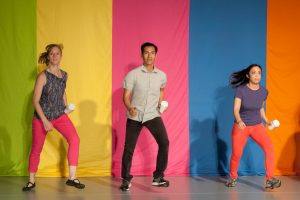
Blythe Barton, John Diaz, and Dina Apple walk to the beat in front of the partition that serves as dressing room.
This Land is Your Land cast local dancers in Mark Haim’s minimalist work that mutates from continuous walking patterns to striking theater and cultural commentaries. Starting with an email, youTURN producers Erica Buechner and Anne Gehman enticed Haim to set the work in San Diego, with dancers volunteering their time and donors funding memorable performances.
- Trolley Dances, Jean Isaacs’ site-specific adventure over two weekends traveled from the new water park downtown to Balboa Park with six dances in unexpected places. The event invites local and guest choreographers and begins with an open audition for dancers, a rarity in San Diego. Days later, Isaacs’ site inspired Dances with Walls, presented at WoW, the Without Walls Festival, featured a passionate duet, comedic soldier trio, and athletic ensemble conjuring the ancient tribes of Stonehenge and the Last Supper.
- Reverberate and Whispering Directions raised the bar at the 2015 San Diego International Fringe Festival. Reverberate, presented by Blythe Barton Dance with the Neave Trio offered two platinum programs in one with energized concert dance and chamber music that cut to the bone.
Inspired by nine months of living in the Middle East, Whispering Directions was tour de force dance-theater created by Gina Bolles Sorensen and Kyle Sorensen of somebodies dance theater. A syncopated score, dancers Sorensen, Angel Acuña and Jaime Nixon plus seven, and 2,000 toy soldiers made this work a Fringe favorite. - Eyes East by team Sorensen topped a “San Diego Dances” show too, with sensuous Gaga style and explosive bursts. Their work is infectious and places this couple on our list of choreographers to watch again.
- Mozart’s Requiem. Known for its exquisite Balanchine revivals, City Ballet founders Steven and Betsey Wistrich made leaps forward with new vision from daughter ballerina Ariana Gonzalez and her talented husband Geoff Gonzalez as choreographer. The program included the premiere of “fourPair,” a series of duets set to Debussy’s “Suite Bergamasque,” and “Mozart’s Requiem” with full orchestra and chorus.
- CHOREOLab2015 gave local dance makers a chance to present work in conjunction with its presentation of Wendy Whelan/Restless Creature. Presented by La Jolla Music Society.
Five San Diego choreographers mingled with the ballet superstar Whelan and presented work to the men who collaborate and dance duets with her – choreographers Kyle Abraham, Brian Brooks, Joshua Beamish, and Alejandro Cerrudo. Dancemakers included: Blythe Barton, Geoff Gonzalez, Ami Ipapo, Melissa Nunn, and Elyssa Dru Rosenberg. Heartfelt criticism and conversation were constructive for both the panelists and those showing work. Viewers witnessed the choreographic process in real time.
- Young Choreographers Showcase is a rare event for emerging dance makers from all genres to present exciting new work with a fully equipped stage. Ariana Siegel’s (B)order garnered the grand prize for Most Original Choreography with its instant tension and use of space, as well as chemistry between Siegel and her partner,Angel Acuña, who won Best Performance by an Individual Dancer. There were surprises.
An additional bravo goes to Danah Fayman (she’s in her mid-nineties and could not attend this year) who supports the next generation of dance makers by underwriting the showcase and $5,000 in prize awards.
- more UNICORN at Space4Art in the East Village at noon on a Saturday had the dreamy quality of the legendary horse creature with a horn growing out of its forehead. Accidental yet directed, the dance grew from a belief that magic is inevitable every time. Performed by Anya Cloud, Eric Geiger, Jess Humphrey and Leslie Seiters, more UNICORN, part two of Unicorn (traces of you linger), was excellent as a live choreographic process and magical as super duets unfolded through Herculean trial and error.
- Blythe Barton and Caryn Glass elevated secondary roles with intriguing dance theater talents in Snakeskin, presented by Malashock Dance. Physical and expressive, they created characters that broke away from a static mold with visceral presence. Barton as Vee the town’s busybody incited group attacks and whispers. Glass as wild-cat troublemaker Carol made bullying and gossiping a deadly sport.
- Five unforgettable touring dance productions plus a musical inspired conversations about a new dance hybrid, Euclid’s
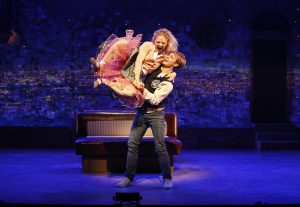
Hayley Podschun and Brendon Stimson in ‘Love with the Top Down,; part of In Your Arms at The Old Globe. Carol Rosegg Photo.
triangles, the nightmare of war, mature dancers reinventing themselves, contemporary ballet and trouble at sea, and our love of fairytale parodies: In Your Arms, Triangulating Euclid, Healing Wars, Wendy Whelan’s Restless Creature, Malandain Ballet, and the musical Cinderella because the dancing was too good to leave out.
Boo for these dance downers
- We love Gene Kelly and rain, but San Diego Musical Theatre’s Singin’ in the Rain suffered from a glued together score and bloated to nearly three hours because of soggy pacing.
- Festivals such as the Fringe and WoW want to draw younger audiences, even children, but both were too complicated for busy people. Schedules were too dense and designed for rich retired folks or unemployed millennials with time and money to burn.
- Thousands flock to The Nutcracker every year. City Ballet and California Ballet turn out two of the biggest and sweetest productions that sparkle with excellent principal dancers and live orchestras, but like an old sugar plum on a wrapper, they are stuck on stereotyped sequences for Arabian and Chinese dances. A new generation needs to take risks and restage them.
- Boo to our city for failing to ensure a worthy Centennial celebration for Balboa Park. We can only imagine what could have been. If only the San Diego dance community that creates masterworks on a shoestring had taken charge instead of city officials and worthless committees who got paid big bucks for nothing. Bravo Trolley Dances for the excellent effort, although the tours were too long.
- Boo to misguided presenters and PR reps, hurried readers and artists who demand only previews for upcoming shows and balk at thoughtful reviews. Writing about dance is not an easy task. It’s been compared to nailing Jello and herding cats. Few publications have a dedicated dance critic, which means nice people write about a few big shows but experience even fewer. That should scare emerging dance makers. To be considered a real art form, dance demands more than quick descriptions, sexy photos, and calendar listings. Dance deserves as much attention as a muffin recipe or sports stadium, and that’s why sandiegostory.com should be on your daily radar. Criticism provides context and true value for the arts. Along with preserving performances and creating historical archives, formal critiques help artists attain important grants. Even a review that is presumed negative may turn positive because it elevates the art itself and promotes dialogue.
One final bravo and thank you goes to all of the artists, stage crews, and volunteers who worked to bring memorable performances to the stages and streets of San Diego in 2015. Though they can’t all be listed here, many performances were compelling, even life changing. With more subscribers and sponsors who share our passion, the writers of sandiegostory.com will keep writing about dance, theater, and music performances and the stories they tell.
Welton Jones on Theatre
I resist year-end wrap-ups, especially the ones that promise a ranked list of shows from the preceding 12 months. (As if separate productions can be compared with anything other than themselves!) But managements continue to demand them because, I’m told, readers like them. So I, a faithful server of readers, sigh and gird myself not only to select a batch of “winners” but also to rank them in order.
As a senior, senior commentator, I reserve the right to cherry-pick shows that I cover. Thus this list also is a batch of the year’s safest choices. After all this time on the job, I leave the experimenting to others because I usually can sense the contenders.
So here’s the list, each decorated with a selected quote from my response in the heat of the moment:
-
Come From Away – La Jolla Playhouse (A musical about airline passengers stranded in Newfoundland on 9-11-01, by Irene Sankoff and David Hein.)
“With just 12 charmed actors and a stage full of assorted chairs, tables and boxes, director Christopher Ashley tells the dozens of stories distilled by the authors, with a galloping can-do spirit that joyously celebrates the source and dazzles the rapt audience. Who would have thought that so much content could be whisked together without losing either coherence or inspiration?”
- The White Snake – Old Globe Theatre (Musical based on ancient Chinese texts by Mary Zimmerman.)
“Instead, this is a sturdy tale of conflict and affection between characters with strong appetites and convictions, who make mistakes, master problems, lose control, lapse into laughter, gain wisdom and transcend their ends. It’s a treasure of Chinese culture, which has been around for literally thousands of years because, when properly told, it’s entertaining, uplifting and generally nifty.”
- Indecent – La Jolla Playhouse (A play by Paul Vogel with extensive klezmer-flavored music by Lisa Gutkin, Aaron Halva and Travis W. Hendrix, who also performed it.).
“Indecent, opening a new season at La Jolla Playhouse, is a splendid production of an intriguing jumble of history, literature, conjecture and interpretation surrounding The God of Vengeance, an impressive European drama from the early 20th Century mainly known now because it included the first lesbian kiss in a Broadway show.”
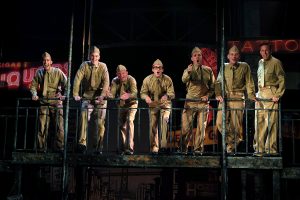
In Cygnet Theatre’s Dogfight, left to right, are Charles Evans Jr., Ben Gibson, Eric von Metzke, Scott Nickley, Alex Hoeffler, Patrick Osteen abd Bryan Charles Feldman. Ken Jacques Photo.
- Dogfight – Cygnet Theatre (A musical by Benj Pasek, Justin Paul and Peter Duchin following a group of new Marines as they prepare for combat in Vietnam.)
“Murray steers the script through an atmosphere of sleaze that suggest the authors are less interested in any common humanity and more anxious to establish a barbarity that these lovers can survive. Murray is OK with this but he also finds ways to ease the damage of crassness while keeping the general tone one of thrusting vitality. The flaws are the author’s.”
- Fringe Festival (A supremely mixed bag of multiple performances in 11 days at 18 venues, including some in Tijuana.)
“What works best at a fast-paced, overwhelming, unfiltered and exhausting show-orgy like the third annual San Diego International Fringe Festival, continuing through Aug. 2, probably are tight niche acts featuring seasoned professionals or loosey-goosey burlesques on familiar themes. Getting too serious amongst the stressful confusion of 80-plus one-house shows in a dozen locales, day after day, can be deadly, especially for artists still finding themselves.”
- Arms and the Man – Old Globe Theatre
“A clever and alert theatrical company combs past catalogues for legacy plays that balance its menu, seeking seasonings of period insight and neglected graces to illuminate its urgent present. The best managements do this so well that a revival can seem fresh and charming just by its selection, production aside. But all is right with George Bernard Shaw’s Arms and the Man, now at the Old Globe in a thoroughly delightful staging of wise wit, addressing concerns and filling needs we may not have realized we had.”
- Up Here – La Jolla Playhouse (A musical set inside the brain of a nerdy millennial by Kristen Anderson-Lopez and Robert Lopez)
“Buried inside the prodigious dazzle of virtuoso stagecraft that out-sparkles many a billion-dollar, special-effects movie – really, you just can’t beat LIVE – the new musical Up Here at the La Jolla Playhouse is just a dear little boy-meets-girl fairy tale goosed with feelgood zowie that lasts for… well, can’t tell yet.”
- Kiss Me, Kate –
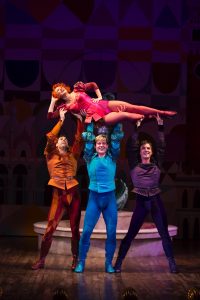
Megan Sikora is lifted by , left to right, Barrett Martin, Giovanni Bonaventura and Tyler Hanes in the Old Globe’s Kiss Me, Kate. T Charles Erickson Photo.
Old Globe Theatre (The classic Cole Porter musical based on The Taming of the Shrew.)
“Thank you, thank you, thank you Darko Tresnjak! Thanks on behalf of all us geezers who remember walking out of musical comedies whistling the songs and floating on the clouds of fantasy. Thank you for not messing too much with Kiss Me, Kate, for keeping it in its period, allowing it to strut the attitude it needs and giving it the room that a masterpiece deserves.”
- End of the Rainbow – Intrepid Theatre Company (A play by Peter Quilter about the days leading up to Judy Garland’s last performances.)
“This show couldn’t happen without a plausible Judy. Thank you, Eileen Bowman, a singing actress of talent, intelligence, energy and timeless allure, who approaches the assignment as an interpretation, not an imitation.”
- (A bag of gumdrops) Buyer & Cellar, Murder For Two, Full Gallop – Old Globe Theatre (Three shows drawing maximum effect from minimum force: Jonathan Tolins’ fantasy of a Hollywood fringe wannabe hired to curate Barbara Streisand’s fantasy cellar; an up-tempo satire on everything Agatha Christie by Joe Kinosian and Kellen Blair; and a flamboyant visit with fashion maven Diana Vreeland as she ponders an offer to assemble the Metropolitan Museum’s costume collection, by Mark Hampton and Mary Louise Wilson.)
Some of these projects obviously have Broadway ambitions. That’s of little interest to me. I continue to write for and from the San Diego audience.
Martin Jones Westlin on Theatre
Bravos
Broadway/SD’s ‘Beauty‘: The Case for Commercialism
Once upon a time, a local theater maven couldn’t help but declare her estrangement from what she saw as the art form’s sense of self-appointment. Today’s playwrights, she mused, think they have to have a message — gays this, blacks that, religion this, ethnicity that, war this, politics that, dysfunctional families the other thing. The approaches, she said, were dulling her wonderment for the sake of wonderment as theater had abandoned its hold on art for the sake of art.
“Me,” she concluded: “I just wanna have fun. I. Want. To. Have. Fun.”
She. Would. Have. Fallen. On. Her. Wallet at the sight and sound of last November’s Beauty and the Beast, Broadway/San Diego’s absolutely splendid entry on the beautiful but nerdy French country gal swept up into a misshapen brute’s castle in a prisoner swap, only to learn that her captor is really a hottie prince, transformed as punishment for what a sorceress perceived as his arrogance. Beast gets girl, of course, as love morphs him and his entourage into the human beings they once were.
This Niederlander production isn’t without its morals, of course — beauty is in the eye of the beholder, can’t judge a book, et cetera — but this show had a positively captivating humanism to it, relying on gentle self-effacement and pitch-perfect tech to make its point. The improvised dirty looks, the impromptu pratfalls, the splendid costumery and song, the fairytale comportment and the unflagging confidence that carried it: This show may reek of commercial triumph, but it brilliantly deferred to the artistic spectacle that yielded that success.
Meanwhile, I can only hope that the majority of patrons were first-time theatergoers, as this show’s mesmerizing spell may well have fueled lifelong interests in the art form. I didn’t see my friend among them when I was there — if by chance she caught the piece, it’s a cinch we have a whole new conversation ahead.
‘Bathwater‘: Durang Mouths Off, and Cast Follows Suit
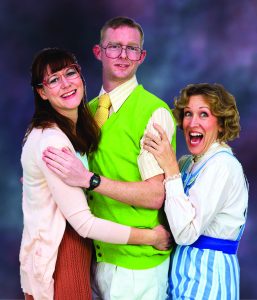
Clueless times three, from left: Helen Dingleberry (Amanda Sitton), husband John (Brian Mackey) and Nanny (Shana Wride). Courtesy photos.
There’s a school of thought among absurdist playwrights that says a decidedly undervalued component — the sound of the words themselves — is actually the writer’s bread and butter. Christopher Durang’s absurdism isn’t as extreme as all that, but with Diversionary Theatre’s very good Baby with the Bathwater, he borrowed a page from the playbook. A’s, I’s and U’s fly off the script with a vengeance, and Durang uses them as a character-development tool as surely as he does the plot.
Helen and John Dingleberry are Durang’s poster children for crappy parenting and marriages of convenience everywhere. They can’t even name their new baby, let alone comfort it when it cries; as you might imagine, their son Daisy is later an unfettered mess. Durang deftly handles him with kid gloves until push comes to shove; he then quickly takes Daisy’s side, revealing that Daisy is soon to become a father himself, determined to avoid his mom and dad’s cluelessness.
And all the while, vowels hang over the stage like lights. A drunken John tries to spell “delirium tremens,” to hilarious effect; Helen’s protracted “Cooooooo; kuuuuummquaaaat” at the start of the show sets the tone for Durang’s linguistic engineering. The vowelar constructs become extensions of the Dingleberrys’ cluelessness, gaping sores that eventually claim the couple’s better angels. Daisy’s fate is less defined; we’re led to believe he somehow approaches fatherhood in relative peace.
The friend I mentioned above — the lady who Just. Wants. To. Have. Fun. — probably wouldn’t like this show too much, as it trains on a specific topic within the national debate. But Durang’s superb talent for language and Diversionary’s eye for gems like his outmaneuver her in no uncertain terms. Baby with the Bathwater was one of the most compelling productions of 2015.
‘Chapter Two’: Credit, However Grudgingly, Gets Its Due
Marvin Neil Simon has written 34 plays, only four shy of William Shakespeare’s mark — but that’s where the resemblance quickly and mercifully ends. Simon couldn’t paint a character frontally if he had a spray can with an automatic nozzle — he unfailingly backs into his characters, opting for wit over substance and instinct over intellect. How this perfectly average early television writer found a home in live art is the true Eighth Wonder of the World — ninth if you count this country’s 2000 general election.
But exceptions necessarily make the rule — and such was the case with North Coast Repertory Theatre’s excellent Chapter Two, Simon’s nod to his late second wife Marsha Mason and his personal blueprint for restarting his life in spite of himself. This March entry actually lived and died by its characters, which is a switch for Simon; he kicked the play’s subtext up a notch and yielded widower George and his intended Jennie, the battle-scarred couple whose female enters into the relationship with no illusions and isn’t afraid to let George know it. Underscoring the poignancy is an understory involving a couple in a relationship neither of them really wants — and above it all sat Simon, for once a true craftsman and stickler for detail, with a sense of dramatic irony that rivals the best of them.
Simon has shown flashes of such sensitivity before, with his Brighton Beach Memoirs unfailingly homing in on the poignant “memoirs” part — overwhelmingly, however, his fame has hinged on warmed-over material he crafted while cocooned amid Sid Caesar’s “Your Show of Shows.” While he never really left TV, he occasionally did take time to observe the world beyond the camera. NCR’s Chapter Two was a very fine case in point.
Boos
Inexplicably, NVA’s ‘The Weir‘ Was As Static As Its Ghosts
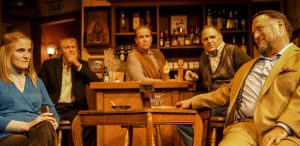
Valerie (Samantha Ginn, left) takes in Finbar’s (Tom Stephenson, right) latest yarn as Jack, Brendan and Jim (from left, Ron Choularton, Max Macke and Tom Deak) look on. Photo by Daren Scott.
There’s a culture to the art of storytelling, especially when the yarns center around ghosts and the otherworld. We all remember sitting with our hearts in our mouths, almost in sync, as the narrator (who might even have been one of us) spins a haunting tale about the other side, with an outcome so real that the characters walk among us, touching our lives as surely as we touch theirs.
The “in sync” part was all too evident in New Village Arts’ October production of The Weir, also the name of the rural Irish pub wherein the aging regulars (who know everything and more about each other) dish on one another and vie for position through the scary stories and desperate fellowship.
The problem is that theater doesn’t do “in sync” very well at all, preferring to fuel its stories through flesh-and-blood characters who sit, stand, ruminate, lapse and otherwise play off the set and each other to illustrate their life paths. Director Kristianne Kurner had none of it, staging the show as a rote reflection of our rapt attention in real life and losing all semblance of character affectation except that supplied by playwright Conor McPherson.
Thirtyish character Valerie draws an interesting contrast between the rest of these blokes, and her story (involving the death of a child) hints that she’s actually had contact with the spirit world. Surely, that alone is enough to rouse an old sot to his feet, if for no other reason than to stretch his legs and his brain. Still, the characters sit in blissful ignorance of everything around them but themselves. Kurner’s direction was exponentially oversimplistic, crafting a work that looked more like a staged reading (given the show’s sum total, that kind of staging might have worked).
Kurner is one of the better theater talents in San Diego County; that’s all the more reason to chalk this show up to the fluke it was, one of the least interesting NVA entries I’ve seen since I began covering the company in 2005.
Diversionary’s ‘Bright Half Life’ Zigs and Zags Itself Offstage
Marriage is either the ultimate exercise in patience or a set of rules broken more often than not. Add four decades on either side of a particular marriage and the fact that the partners are gay women, and you have Bright Half Life, Diversionary Theatre’s November nod to married life’s crazy-quilt trajectory.
Audiences were asked to piece together a nearly 40-year bond between the principals (one white, one black) out of sequence — the couple’s divorce, for example, might take place before their first skydive, while discussions about their parents precede those about the new bed. All that darting between time and space calls for the stylized acting that corroborates it — yet playwright Tanya Barfield’s characters never adapt to the fray, their physical affectations almost in lockstep as time lurches and retracts. It never made sense to the people in the seats, as though the characters’ kaleidoscopic lives were presented in the same color.
The lack of exposition is a huge factor in the play’s ineffectiveness as well. Erica’s a writer, but we don’t know what she writes about; Vicky its Erica’s supervisor at work, but we’re never told what her company does. In one respect, the lack of detail serves the action, because there’s less information to absorb given the zigs and zags in time — the trade-off is that the characters are that much less complete.
This play condenses 40 years into about 70 minutes, with the flurry of events reflecting one relationship. Somehow, Barfield and director Lydia Fort had this disconnection looking like an improv rehearsal, one whose particulars horribly confused the natures of the lives we never got to experience.
NCR’s ‘Fox on the Fairway’ Never Made Par
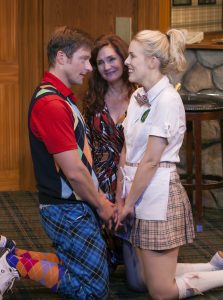
Justin (Kyle Sorrell, left) only has eyes for Louise (Ashley Stults) as siren Pamela (Jacquelyn Ritz) looks on. Photos by Aaron Rumley.
‘Fox on the Fairway’ playwright Ken Ludwig wrote that the critics who pan his piece simply don’t understand what he’s trying to do with his story. He’s absolutely right about that. They don’t. That’s because he never does much of anything at all. Not only will he fail to explain how a golf course is an appropriate setting for a story about young love; he gives his characters — and by extension, us — no say in the matter.
This absolutely dreadful farce, produced by North Coast Repertory Theatre last September, pretends to center on happy couple Louise and Justin, who find bliss amid a rivalry between two storied golf clubs involved in a longtime best-man-wins tournament.
The bride-to-be loses her engagement ring in a toilet; one of the club proprietors nearly loses his wife’s antique shop; and the other is terminally fashion-challenged amid his collection of outrageous golf sweaters. It all sounds absurd enough, in the tradition of competent farce — but Ludwig utterly fails to draw his characters by way of their backgrounds and potentials. For all we know, Louise and Justin could have met at work as on the golf course; we’re simply not privy to the information that drives the principals, and that applies to each and every character.
This was an honest effort by a cast and director who had absolutely nothing to work with. The personnel’s game embrace of the shoddy material unavoidably made them look that much worse, and that speaks volumes about Ludwig’s strange defense of the play.
He correctly figured that the best defense is a good offense — his protestations, in fact, are the only relevant opinions about a piece that was over before it got off the first tee.
David Dixon on Theatre
Bravos
Come From Away. The world-premiere musical at the La Jolla Playhouse was one of the more inspiring theatrical experiences of 2015. Artistic director, Christopher Ashley, writers, Irene Sankoff and David Hein, and an eclectic ensemble told the Newfoundland September 11 drama with passionate style. The production was a testament to the power of human decency.
End of the Rainbow. Eileen Bowman got a lot of raves for playing the tragic icon, Judy Garland, and she deserved all the acclaim. Jeffrey Jones and musical director, Cris O’Bryon, were no less captivating in Intrepid Theatre Company’s staging as two men deeply affected by the Hollywood star’s demise. Producing artistic director, Christy Yael-Cox, turned her intense version of Peter Quilter’s script into both a Garland tribute and a bittersweet cautionary tale.
Cabaret. Director/choreographer, Ray Limon, offered a sexy and wickedly funny take on the musical classic at Welk Resorts Theatre. Without downplaying the cynicism, he made the Kit Kat Klub an environment of sensual enjoyment and pleasure. Limon handled the rise of Nazism in goosebump inducing fashion, which made the evening more emotionally devastating.
Hay Fever. Cygnet Theatre offered strong renditions of Noel Coward’s The Vortex and Hay Fever. The latter was an often-uproarious comedy where Rosina Reynolds, Charles Evans Jr., Rachael VanWormer and Paul Eggington all clicked as a wildly dysfunctional family. Seeing the Bliss clan interact with their helpless hosueguests led to many hysterical moments.
Side by Side by Sondheim. The North Coast Repertory Theatre hosted a sharp and intelligent tribute to the beloved Stephen Sondheim with artistic director, David Ellenstein, at the helm. The 1976 revue was a clever, lush and sometimes educational experience, The musical also served as a showcase for the talents of Angelina Reaux, Rena Strober, Nicholas Mongiardo-Cooper and especially musical theatre star, Randall Dodge.
Boos
Sunset Park. The biggest problem at Scripps Ranch Theatre’s staging lied in the script from Marley Sims and Elliot Shoenman. Their dialogue consisted largely of obvious jokes and punchlines. What could have been a really funny look at aging was instead an only occasionally interesting comedy.
84 Charing Cross Road. In spite of an intriguing concept, the unexpected friendship drama at Lamplighters Community Theatre suffered from a narrative that did not give audiences enough insight into the main characters. Actors Kelly McKenna and Brian P. Evans did what they could to liven James Roose-Evans’ prose, but the overall plot was sadly not very interesting.
Mo’olelo Hiatus. Not so much a boo, but still extremely disappointing news. Audiences will not have the opportunity to know what former executive artistic director, Lydia Fort, might have accomplished at the Tenth Avenue Arts Center. In spite of financial issues, it would have been great if the rest of the promising season could have at least continued through next May. No one deserves blame for the temporary break, but the situation for the terrific theatre company is very frustrating.
Bill Eadie on Theatre
The 2015 theatre season was a mixed bag this year. There were a few really fine productions, several better-than-average, and a lot of middle. Even the weaker productions had something to recommend them. I don’t have a great many standouts, but then I don’t have a great many things to boo about, either.
-
Bravo to La Jolla Playhouse, which put together a season heavy on world premieres and for the most part made them work. And, a particular bravo to Irene Sankoff and David Hein, the Canadian pair who interviewed the people of Gander, Newfoundland, and airline passengers they hosted immediately following the 9/11 attacks, and who produced from those interviews the most charmingly uplifting and humane musical I have ever seen: Come From Away. Bravo, too, to director Christopher Ashley and a team of performers (including an onstage band) who sacrificed individuality to make the collective shine. Both San Diego and Seattle audiences have embraced this gem, and I hope it has a long life beyond these initial productions. One more bravo in this thread: La Jolla Playhouse put together three collaborations to bring us three high quality shows. It teamed with Seattle Rep for Come From Away, with Kansas City Rep for Blueprints to Freedom and with Yale Rep for Indecent.
- Bravo to Intrepid Theatre Company for re-making itself a second time, for landing a theatre space from the City of Encinitas, and for producing quality work despite moving from location to location (a necessity until the Encinitas space is ready for them). Last summer’s production of Jane Anderson’s play, The Quality of Life was one of 2015’s highlights. Though not a great play, it was a provocative one, and high quality casting and direction (by co-artistic director Christy Yael-Cox) made for a memorable evening.
- Bravo to San Diego REPertory Theatre, whose 40th anniversary season has already produced three memorable pieces of theatre (Violet, My Mañana Comes, and The Oldest Boy) with more good work expected in 2016. Thanks, artistic director Sam Woodhouse, and the entire REP team for both delighting and challenging San Diego audiences, and bravo to the REP for having its production of Honky broadcast on PBS On Stage America (follow the link if you’d like to stream the broadcast).
- Bravo to many San Diego theatre companies for producing world premiere theatre in the past year. San Diego has always hosted new work, but there was a decided uptick in the number of readings and full productions this year.
My only Boo is one where I can’t yet place any blame, just express my disappointment in the situation. Recently, the board of Mo’olelo Performing Arts announced that it was canceling the remaining two productions of its 2015-16 season and shutting down operations as of January 1 for a period of at least six months while the board searches for a financially viable way forward. I gave Mo’olelo a bravo last year, because it looked as though the company had handled a transition from one artistic director to another quite smoothly. But, the board’s message characterized Cell, the opening production of the current season as unsuccessful, and the artistic director departed soon thereafter. I hope that we do not lose this company, which has a record of producing work by and featuring people of color, as well as paying its acting company at professional rates.
***
The final bravo goes to our readers. Thanks for your compliments and critiques. Thanks for thinking enough of our work to seek it out. Thanks to those of you who help us pay the bills through your contributions (we do this as a labor of love, but we do have expenses – see the donation link to give us a hand). We look forward to continuing to cover arts in and affecting San Diego in the year ahead.

In addition to reviewing theatre for San Diego Story, Bill also reviews for TalkinBroadway.com. He is a member of the San Diego Theatre Critics Circle and the American Theatre Critics Association. Bill is an emeritus professor in the School of Journalism and Media Studies at San Diego State University.

![Franco Pomponi, Chen-ye Yuan & Chad Shelton [photo (c) Ken Howard]](http://www.sandiegostory.com/wp-content/uploads/2015/03/Nixon_guy_trio-300x208.jpg)
![Borromeo String Quartet [photo (c) Eli Akerstein]](http://www.sandiegostory.com/wp-content/uploads/2015/08/Borromeo-w-cello-Eli-Akerstein--200x300.jpg)
![Daniil Trifonov [photo (c) Alexander Ivanov]](http://www.sandiegostory.com/wp-content/uploads/2015/01/Trifonov4_cphoto_AlexanderIvanov-300x200.jpg)
![Michael Francis [photo (c) Marco Borggreve]](http://www.sandiegostory.com/wp-content/uploads/2015/06/Michael_Francis_Borgreve-200x300.jpg)
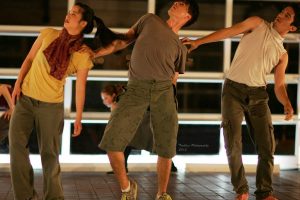
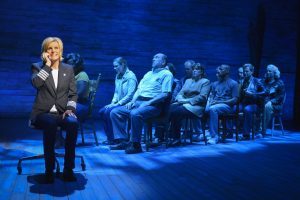
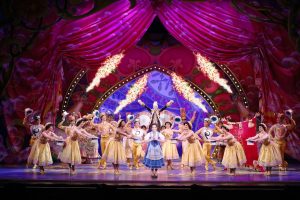

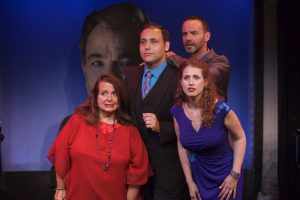
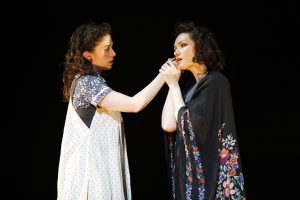
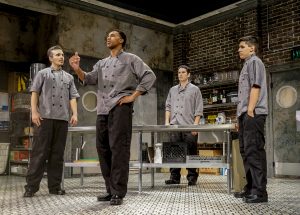
Wonderful recap of the year in performing arts! Thank you Kris for all you do support the dance community!
Thanks Kris,
Dance needs both Previews and Reviews as each satisfies different needs and purposes.
What a thoughtful sum up and nod to the future of dance in San Diego. Thank you, Kris!